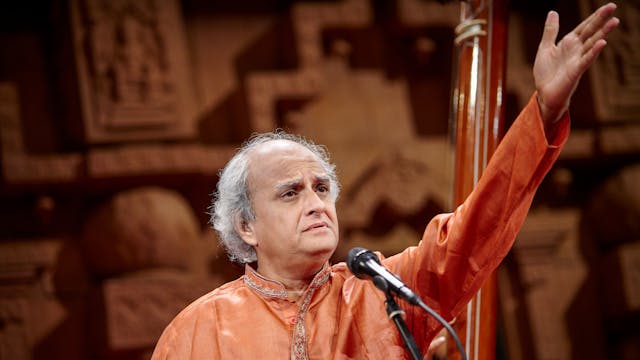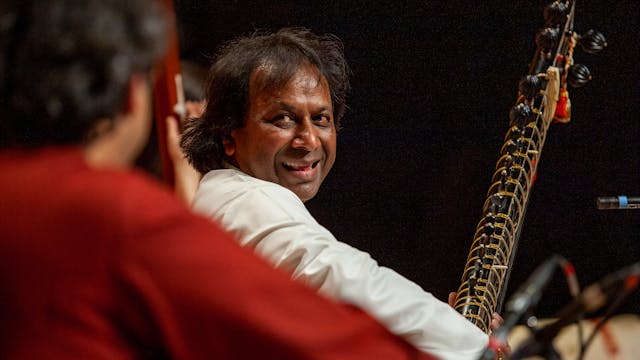Parveen Sultana | Thumri in Mishra Bhairavi
Thumri and light classical
•
26m
Recorded at Darbar Festival 2007, on 15th April, at the Phoenix Theatre, Leicester.
Musicians:
- Begum Parveen Sultana (Patiala gharana)
- Partha Sarathi Mukherjee (Tabla)
- Chiranjib Chakraborty (Harmonium)
- Gunwant Dhadyalla (tanpura)
- Nina Burmi (Tanpura)
- Ranjana Ghatak (tanpura)
- Debipriya Das (support)
Thumri, Yaad Sataye Din Rayn Mitwa, Raag Mishra Bhairavi; Thaat: Bhairavi; Samay: Morning
This thumri in Mishra Bhairavi is an incredible rendition by Begum Parveen Sultana. Beginning on a slow lilt, this romantic piece features the best vocal nuances of Begum Sultana. It is a spellbinding rendition that showcases her Patiala gayaki as well as features the most youthful vibrance that she still exudes on stage.
Performed in 2007, this lighter piece in Mishra Bhairavi is the concluding song sung by her, bringing the three-day festival to a happy end. She augments the romance inherent in the piece with profoundly moving improvisations, creating an intense ambience.
Partha Sarathi Mukherjee picks up the swag of the rhythm intertwined with the lyrics with remarkable precision and aesthetic grace. Chiranjib Chakraborty’s powerful and emotive accompaniment augments the overall performance making it sparkly, powerful and dramatic.
Bhairavi is an early morning raga, however, it is traditionally performed as the concluding piece of a concert in the Hindustani system. This is because it is a very versatile raga and can be portrayed in myriad hues. Pandit Hariprasad Chaurasia feels that every musician must practice Raag Bhairavi till he/she breathes his last because it is not possible to capture its versatility in a single life-time.
Up Next in Thumri and light classical
-
Pandit Ulhas Kashalkar | Raag Bhairavi
Recorded at Darbar Festival 2011, on 24th April, at King's Place, London.
Musicians:
- Pandit Ulhas Kashalkar (khayal)
- Pandit Suresh Talwalkar (tabla)
- Sameehan Kashalkar (supporting vocals)
- Chinmay Kolhatkar (harmonium)
- Priya Prakash (tanpura)Raag Bhairavi; Thaat: Bhairavi; Samay:...
-
Ustad Shahid Parvez | Bhairavi
Recorded at Darbar Festival 2007, on 15th April, at the Phoenix Theatre Leicester.
Musicians:
- Ustad Shahid Parvez (sitar)
- Pandit Yogesh Samsi (tabla)
- Debipriya Das (tanpura)Raag Bhairavi; Thaat: Bhairavi; Samay: Morning
Parvez’s portrayal of Bhairavi is deeply profound; In this piece fr...
-
Arati Ankalikar Tikekar | Chaiti
Recorded at Darbar Festival 2011, on 23rd April, at King's Place, London.
Musicians:
- Arati Ankalikar (khayal vocal)
- Anubrata Chatterjee (tabla)
- Chinmay Kolhatkar (harmonium)
- Omkar Dalvi (pakhawaj)
- Priya Prakash (tanpura)
- Shobhana Patel (tanpura)Song: Chait Maas Bolele Koyeliya ...



